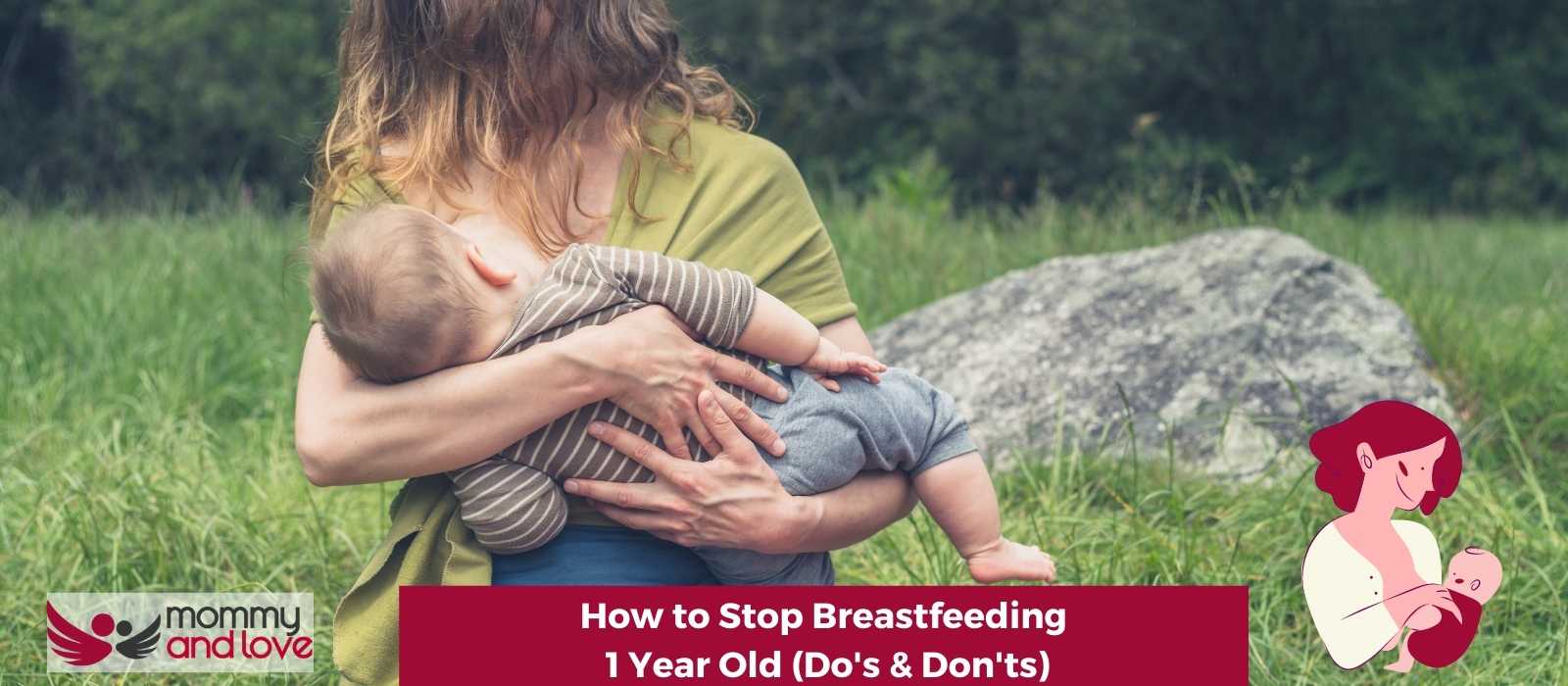So, you’ve reached a fantastic milestone, Mom! You should feel incredibly proud of your achievement!
You’ve given your baby the best start in life by feeding them for a full 12 months, just as the world health organization recommends!
You’ve also smashed the American Academy of Pediatrics’ recommendation that you breastfeed for the first 6 months of your baby’s life and then continue to breastfeed as you introduce your baby to a range of new foods until they reach the age of 1.
But now that you’ve reached this milestone, you may be wishing to wean your child off breastfeeding….
Is the time right for you?

When to start weaning off breastfeeding is a completely personal decision, and you will reach this stage in your own time and at the right point in your life.
It’s not always just mom’s decision. Sometimes kids will start to show more interest in eating solid foods and will lose interest in breastfeeding, so the decision is made for you.
There are various reasons why you might want to stop breastfeeding when your child hits the 1-year mark.
Whether it’s because you and your husband or partner have decided to have another baby, or you’ve taken on a new job and won’t find it easy to breastfeed, the decision is yours to make….
Having said that, weaning your child off breastfeeding can come with a few pitfalls.
Here are our hints and tips for making the weaning off process as simple as possible – for you AND your child….
Go easy on yourself!
So, here’s our first tip – one that doesn’t even concern the weaning off…
Remind yourself that this period may set off emotions that you’re not expecting!
While some moms are more than ready to stop breastfeeding by this stage, others will run the gamut of emotions as they not only give up a practice that’s been part of the daily routine for a whole year but have to ensure that their child adjusts to this new routine with as little anxiety as possible.
Some moms will be delighted that their body is their own again…
Some will feel sadness that a special period of their life is over…
Some will feel frustrated if their child goes through a period of readjustment that involves wakening during the night looking for a feed….
A young child feeding is a special bond, and when they move onto milk or even pumped milk in a bottle or sippy cup, and the breastfeeding sessions slow down, it can be a major life change for both you and your baby.
Don’t panic!
Just face the fact that there will be a period of transition and go with the flow.
And, above all else, don’t let yourself be overwhelmed by feelings of sadness or – even worse – guilt!
After all, you’ve seen your baby through the first 12 special months of their life. You’ve given them the best start, but, as with anything else, life goes on and changes. It’s a matter of ensuring that both you and your child adjust to this new stage with as much ease as possible.
Don’t give up on the bonding time!

If you feel regret at the fact that you and your child will no longer share that special ‘bonding’ time during breastfeeding, then simply change the way in which you bond.
Spend more time with your child reading, rocking or enjoying quality, one-on-one time. Your bedtime routine may no longer include a bedtime feed, but you can still have that close one on one time together. The breastfeeding session was important, but so is just talking or cuddling your little one.
Many toddlers seek continued breastfeeding for closeness, so it’s important if you are stopping breastfeeding to let them know that you aren’t stopping the close bond you have.
Slow and steady….
Weaning your child off breastfeeding isn’t a race….so take the time to wean them gradually. It will benefit both you and your child if you ‘step down’ the breastfeeding rather than making them go ‘cold turkey’.
Try dropping one or two nursing sessions at a time and then wait for your body to adjust, you want to prevent engorgement in your milk ducts. Keep on doing this until your milk supply has tapered off and you have more or less removed all of your nursing sessions even down to just one feeding.
So, now that you’ve got your head in a good place, here are the steps to wonderful weaning…
The ‘how to’…
To prepare your child for being weaned at 12 months, you need to start the process by 6 months by getting your child to start a solid diet. This will help ease your baby through this transition period.
The weaning process
There’s no doubt that the best way to wean your child off breastfeeding at 12 months is to do it gradually. Stopping completely in one fell swoop will simply upset your child and make you feel as guilty as hell.
It will also leave you with breasts that are pumping milk that has nowhere to go and you may even cause yourself breastfeeding pain inflammation called mastitis.
‘Gradual’ is your buzzword for this process…so wean your child off over a period of weeks. This will allow your child to get used to the taste of plain, whole cow’s milk or fortified, unsweetened soy beverages.
It will also allow them to adjust to drinking from a bottle or cup.
By the way, over the age of 12 months, your child doesn’t need infant formula or ‘toddler’ drinks or formula. Plain cow’s milk is absolutely fine.
Start off by replacing one breastfeed a day with a cup of plain cow’s milk and then offering a small portion of food. This will not only help in the breast milk reduction process but will encourage your child to experience different flavors.
Over the period of a few days, you can then replace another feed with cow’s milk.
It can also help if you offer your child water in a soft-spouted beaker instead of a breastfeed.
Over the period of a few weeks, you’ll hopefully reduce your child’s breastfeeding to zero.
What happens if your child doesn’t WANT to stop nursing?
Obviously, you’re going to give your child time to adapt to this new practice. But what happens if they make it clear they have no interest in being weaned off breastfeeding?
What do you do then?
Well, you could try the ‘putting off’ method. This means that, if your toddler asks to be nursed, you distract them by suggesting another activity and telling them that you’ll feed them later. Bedtime is a good suggestion. You can start talking about other things, and help them with other ways to get to sleep.
Older children should learn to sleep without being nursing sessions.Gradually, parents find that their requests start to drop off and you can complete the process in that way.
Take Away on How To Wean Off Breastfeeding At 12 Months
If you want to continue breastfeeding an have extended breastfeeding, that is up to you and your child to decide, if its mutually desired, then its your own body, so carry on until you are ready.
Don’t feel pressurised by other moms, other children or what other parents are doing. Do what suits you and your child. Remember, if you are thinking of continuing breastfeeding an older child or older toddler, then do it until the time feels right for you. Many children are fed until they are 2-3 years old.
When you are ready to wean, make sure you take a gradual approach, change the old routine at regular intervals, dropping one feed at a time. Avoid weaning all of a sudden. Just because you no longer nurse your toddler, its important to give them emotional time. Most toddlers find it easier if they still have that close bonding time with you.
If you miss breastfeeding, you can always consider becoming a la leche league leader, to help other parents on their special breastfeeding journey!
So, there you have it. Everything you need to know about how to stop breastfeeding at 12 months old. Just remember to take things slowly and don’t stress yourself out – after all, this is a process that should be enjoyable for both you and your child!

This article was written by Sandra Baker – full time writer and the mother of four amazing kids (including twins!)
She’s also a breastfeeding counselor and has spent years helping new parents learn how to care for their children. When she’s not writing or caring for her children, Sandra likes to spend time reading and taking walks with her husband.




